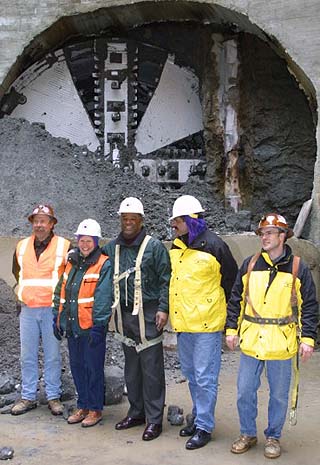
Surveys
Awards
DJC.COM
March 28, 2002
Sewer Rx: Clamp down on leaky pipes
Trenchless Resources International

Photo by Ned Ahrens/King King County Executive Ron Sims, center, with project personnel at the Mercer Street tunnel “breakthrough.” The 1.2-mile tunnel is part of the Denny Way/Lake Union Combined Sewer Overflow Project, which will reduce overflows of sewage and stormwater in Lake Union and Elliott Bay.
|
For Metro to get the original 17 cities and sewer districts to agree to its concept, an agreement was established that ALL wastewater flows would be accepted at the treatment plants until 2016.
Today, after the merger of Metro and King County, about 34 cities and sewer districts utilize the combined entities’ wastewater treatment plants — the two major plants are located at West Point and Renton — with the a time table extension until 2036.
When Metro was established, two types of sewer systems were being used: combined and separated. Combined sewers transport both stormwater and sewer wastes. Separated systems are designed to transport only sewer waste.
As sewer systems age, they develop cracks, leaks and holes that allow groundwater and stormwater to enter, especially during wet weather events. Many of the sanitary sewer systems in our area are over 50 years old; some in Seattle are over 100 years old.

Jurgens |
During the past 10 years, rapid development and continued deterioration have taxed the sewer systems’ capacity and structural integrity. These systems are further stressed during wet weather, when infiltration (groundwater and stormwater that infiltrate the system through leaky pipes and manholes) and inflow from the combined system (stormwater that enters the system through direct connections such as catch basins, area drains and roof leaders) add to the peak flow. Peak flows equates to peak discharges at the wastewater plants.
Peak flows from infiltration and inflow (I/I) is the focus of King County’s effort to reduce and eliminate extraneous waters from entering the sewer systems.
King County’s original 1958 charter did not call for ongoing efforts by the local agencies to reduce I/I. Today, a cooperative effort by the contributors to King County’s system is necessary.
One of the largest challenges is convincing the agencies that I/I reduction is possible. In the 1980-90s, EPA funded many programs for reduction and removal of I/I. The majority of these programs failed to accomplished their stated goals.
Reasons for the failures were due to a variety of issues, including but not limited to:
- Understanding hydraulic transfer of the water table
- Understanding the ability of chosen processes to accomplish the desired results
- Understanding if a product of process is used or installed properly
- Recognizing the effect of rain-induced infiltration
Today in King County, a major effort is under way to prove to agency officials that removal of I/I is possible. In the near future, a series of pilot projects will verify the ability of engineers to access field issues, insuring that successful methods, procedures and practices are used in reducing peak flow influences on the King County system.
In some jurisdictions around the nation, uncontrolled peak flows have caused sewage overflows, EPA lawsuits against the public agencies for violations of discharge permits, and building moratoriums.
In the past, sewer maintenance has been viewed as a remedial activity to repair catastrophic failures of pipes and manholes. Gradually increasing leaks and unauthorized storm water connections have been accepted as inevitable consequences of an aging system.
Nationwide, the management of wastewater infrastructure systems has changed significantly in the past decade. Realizing that sewer infrastructure is an asset that must be preserved, many municipalities now consider the condition and integrity of underground infrastructure critical issues.
The proper management of collection systems entails more than finding leaking pipes, however. An effective I/I program must be incorporated into the long-term strategy of a utility’s operations.
Recent national studies show that I/I rates increase with time unless a collection system is systematically evaluated, maintained and rehabilitated. As the program grows in the King County area, a new awareness will occur concerning this segment of our underground infrastructure.
John F. Jurgens is a principal of Trenchless Resources International of Bothell. He can be reached at (425) 487-3325.
Other Stories:
- How to survive the construction recession
- Building a 'fertile crescent' in Snohomish County
- Is this the end of differing site conditions?
- Scope creep and other scary things
- 2002: A slow year for construction grads
- Delivering the pitch after making the short list
- How a creative agency can work for you
- Volunteering: A habitat for learning construction
- Want to dispute that bid? Better act quickly
- Murphy sells more than backhoes and bulldozers
- Church rebuild strays from standard scripture
- 7 ways to recession-proof your company
- No relief for bid-shopped subs
- A lesson in constructive diversity
- Need more business? Call on Uncle Sam
- Put a cap on skyrocketing insurance costs
- Avoiding pitfalls in pipeline restoration
Copyright ©2009 Seattle Daily Journal and DJC.COM.
Comments? Questions? Contact us.